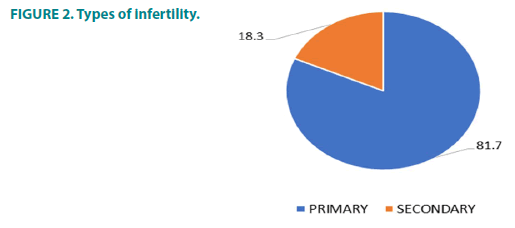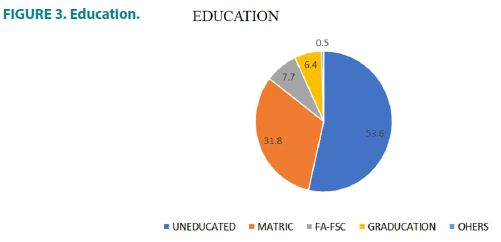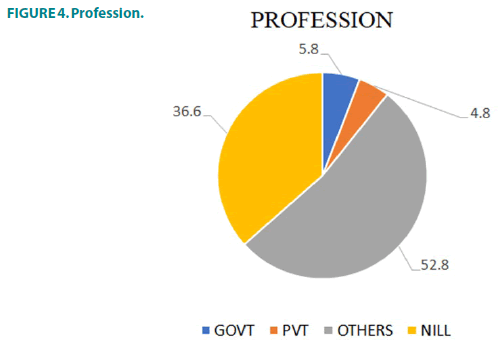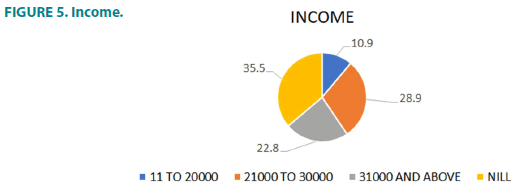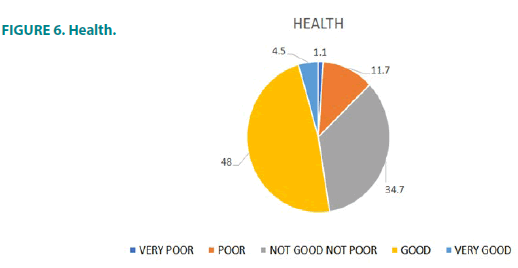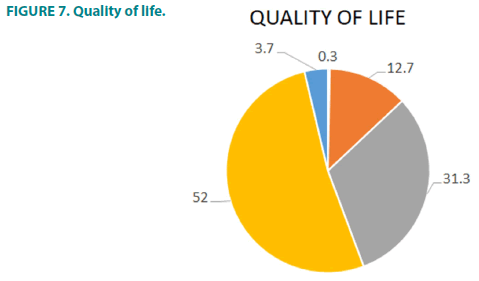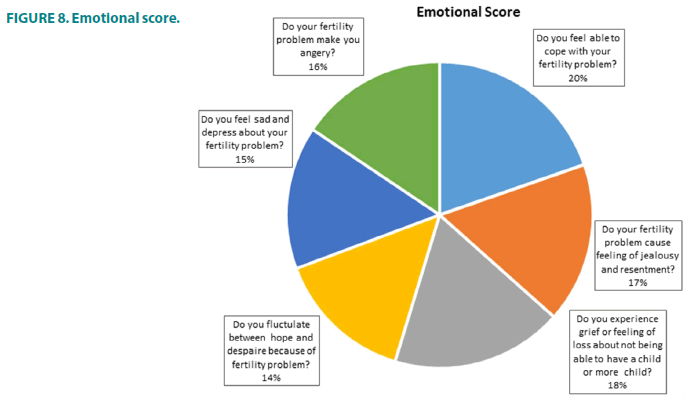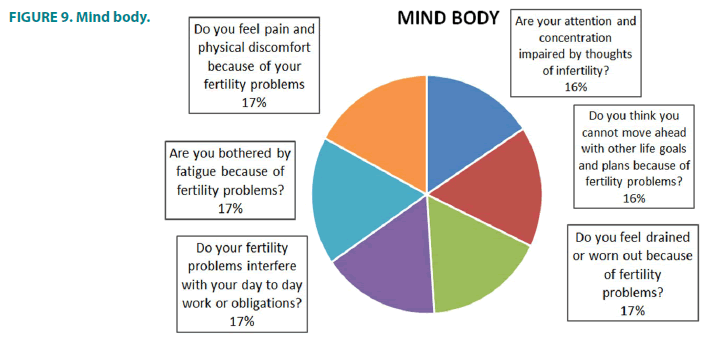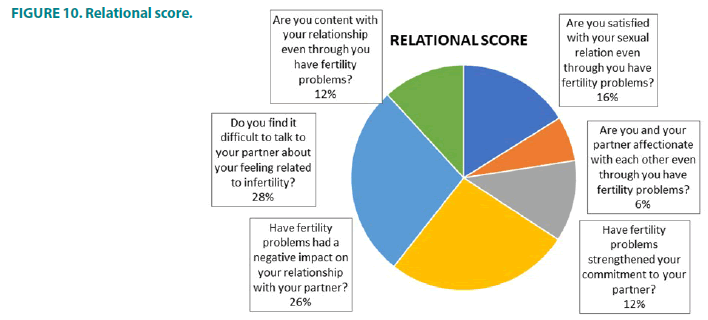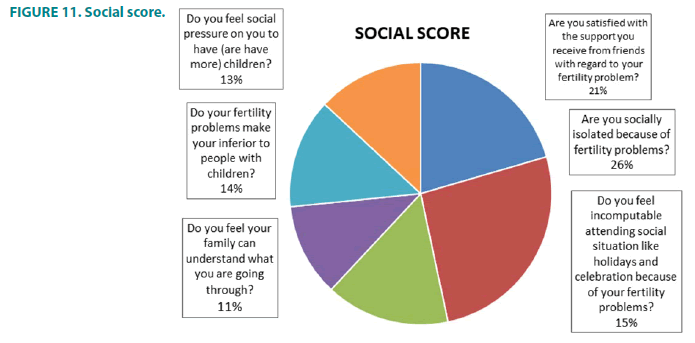Research Article - Clinical Practice (2023) Volume 20, Issue 4
Quality of life among men and women diagnosed with infertility in Khyber Pakhtunkhwa
- Corresponding Author:
- Maria de
Department of Biochemistry, Universidade Estadual de Campinas, Sao Paulo, Brazil
E-mail: mariade@gmail.com
Received: May 17, 2023, Manuscript No. FMCP-23-98985; Editor assigned: May 22, 2023, PreQC No. FMCP-23-98985 (PQ); Reviewed: June 06, 2023, QC No. FMCP-23-98985; Revised: July 18, 2023, Manuscript No. FMCP-23-98985 (R); Published: July 26, 2023, DOI. 10.37532/2044-9038.2023.20(4).1-11
Abstract
Background: Infertility is the foremost sensitive issue throughout the globe, it is the inability of a couple to connive or carry pregnancy. There are two type of infertility: Primary infertility and secondary infertility. The primary infertility refers to the couple have never conceived while secondary infertility refers to the couple is unable to conceive are carry pregnancy after erotic contact without use of any contraceptive methods. The statistics shows that the existing prevalence of infertility is more than 72 million around the world. Pakistan is developing country and the data is not compiled Pakistan is developing country and the data is not compiled, also is very limited statistic has been published in this regard.
Objective: The objective of the study was to assess quality of life among men and women diagnosed with infertility in Khyber Pakhtunkhwa.
Methodology: Cross sectional study was conducted infertile people (n-377) in outpatient clinics of Khyber Pakhtunkhwa. To assess quality of life of infertile couples adopted standard FERTIQOL was applied with certain variables relevant with study context. Data analyzed with SPSS software version 22 and finding present with figures and tables.
Results: The study found that infertile couples have low quality of life score 63.84 out of 120. According to study tool (FERTIQOL) Furthermore, study showed there was poor emotional condition which score was 14.29, mind body score was 15.49 which also poor. The relational score was 18 which concede average and social score was 16.05 which represent poor state of life. Infertile couple quality of life had association with deferent socio demographic variables like age, gender, education, income and types of infertility but not significant. The only significant association was fond gender and education. Calculated p-value was 0.00 and 0.16 correspondingly.
Conclusion: On the bases of study finding it’s concluded that infertile couple had low quality of life score. Furthermore, infertile people have poor emotional, mind body, social condition and average relational state of life.
Keywords
Infertility, Infertility female, Infertility male, Fertility clinics, Quality of life
Introduction
This focuses here on background information regarding the statistics of quality of life of infertility people and their problems, which they face in the society. Furthermore, objective of the study operational definition and importance of the study be enclosed with their appropriate framing.
Infertility is the foremost sensitive issue throughout the globe, it is the inability of a couple to connive or carry pregnancy. There are two type of infertility primary infertility and secondary infertility. The primary infertility refers to the couple have never conceived while secondary infertility refers to the couple is unable to conceive are carry pregnancy after erotic contact without use of any contraceptive methods [1]. The statistics shows that the existing prevalence of infertility is more than 72 million around the world [2]. Furthermore, there is 10 to 15 percent of couple suffering from infertility worldwide. The ratio of infertility in developing countries is quite high and the prevalence of Bangladesh 24.5% [3,4]. Pakistan is developing country and the data is not compiled, also is very limited statistic has been published in this regard.
The prevalence of infertility has been estimated as approximately 22% [5]. Primaries were 3.5% and secondary was 18.4% [6]. Infertile couple feels psychological problems [7]. Because, children are the symbol of future for the parents, source of pride and continuation of family [8]. Research objective are the clear statement of scholar to achieve the aim of the study clear and concise objectives keep and guide the investigator to conduct study [9,10]. To assess quality of life among men and women diagnosed with infertility in Khyber Pakhtunkhwa.
∎ Rational/significance
Infertility is very sensitive issue around the world and a lot of people are suffering from these problems approximately every fourth person have this problems the Pakistan is developing country and the total population is around 22 million but very inadequate statistic compile in this problem. One study conducted in baqai medical reproductive health center the prevalence shows 21.9 and second published study in bolan medical college quetta now it has a great need of Pakistan to identify the specific data regarding these kinds of people. There is no specific data about the quality of life regarding infertility, a very limited statistic has been published on infertility in Pakistan therefore this study will be an addition of knowledge in this regard. So this study will help to assess quality of life among men and women having infertility and also help in planning better health management in future. This study would also contribute and update nurses and other health care workers to maintain standards in care to address the physical and psychological ailments resulted from infertility, to promote quality of life.
∎ Overview
Infertility is foremost sensitive issue worldwide, its effect quality of life of infertile people. Sterility couples face different physical, social and psychological problems like stress anxiety depression and social isolation. For the following purpose different search engine like pub med, google scholar, BMC health services, science hub were accessed for literature review. Researcher included those articles which were in English language and related to study topic e.g. quality of life of infertility couple and not old more than 2000. Correlated Articles were study in depth, reviewed and paraphrased.
Infertility is a condition that inability of a couple to conceive is carry pregnancy. There were two types of infertility primary infertility is refer to a couple have never conceive and secondary infertility is refers to the couple is unable to conceive after one year of unprotected contact [11].
Infertility causes physical and psychological problems between men and women that affect the couple’s quality of life [12]. Pakistan is a country in the world that the majority of the populations live in close family. Pakistani society people expect the couple after marriage to give birth to a child after marriage. People think that children are a symbol of wealth and a source of pride. In addition, more children are security and continuity of the family [13].
Moreover, children give value to extend family system and infertility is unexpected to meet family expectation [14].
Children give hipness to the family and it is a binding force between wife and husband. But when the couple is infertile faces physical, social and verbal harassment, social isolation from events like weeding and engagement [15]. Infertility is the miserable condition of couple, which affects quality of life of infertile individual and lot of people are suffering from this problems in the world. According World Health Organization (WHO) that infertility is a problem that has so many psychological, physical and social effects on human body [16].
A study carried out in Iran from 2009 to 2010 stated that infertility caused multiple social and psychological problems. Also, infertile couples have more stress, anxiety and distress than other people. Women are more stressed than men [17].
The prevalence of infertility is increasing day by day and the prevalence is varying from one country to other. Approximately, there was 80 million infertile couple throughout the world and there were two million couple living in Iran [18].
Pakistani society has a low level of formal education and people blame the woman for giving birth regardless of whether the man has infertility problems [19]. Study conducted in Iran the authors claim stated that infertile women have many health problems in the form of mental health and emotional problems [20]. Infertility is not a health problem only in an underdeveloped country, it is also a health problem that affects life in a developed country like the United States of America and the number of infertile people increases every year. There were multiple causes of infertility in both sexes. 30% was male and 30% was female and remaining 40% were male and female both.
There are a lot of infertility factor like anatomical abnormalities, hormonal changes, age factor, metabolic problem, tubule disease, use of drugs, genetic problem, anti-phospholipid syndrome, infection, use of cigarette smoking. Infertility affects mental health as well as physical health. It is also affect sexual desire and selfesteem. And loss emotionally concentration of couple which become challenges in life.
A study carried out in Iraq in the period from 2002 to 2001 found that there were 77% of causes of primary infertility and 22% of secondary ones. Male infertility was 36%. The most common cause of female disorder was ovulation 41% and tube related problem 5%.
According to World Health Organization (WHO) quality of life define perception of the people in their context of culture, relation, valve of system. Furthermore, possible measurement of health condition, emotional symptom such is depression, anxiety and stress subjectively feeling. Nursing is the backbone of health care system nurses provides health services to the community in different aspect in the form of complete health. The role of nurses is very important in the curative care and preventive care. The nurses apply the following approaches for the betterment of people in the health care system, which consists of the following components. Health assessment, nursing diagnosis, planning, an implementation and outcome evaluations are the key elements in the nursing profession.
Materials and Methods
∎ Study design
This was a descriptive cross sectional study among people with infertility from Khyber Pakhtunkhwa, Pakistan. The descriptive study is related to the detailed observation of human behavior; what they think, say and do. One of the keys to this type of research is that it describes existing phenomena; it is applied to identify detailed information about all the characteristics of the specific problem. This is the quantitative approach and the researcher obtains information without interfering with the data and obtains them through a systematic and objective process.
∎ Study sitting
Data were collected from across five clinics, in different districts of Khyber Pakhtunkhwa, Peshawar, such as Lower Dir, Upper Dir, Malakand, Swat, Mardan and Peshawar. The questionnaire was translated into Urdu and completed by the participant after informed consent.
∎ Study participants
Data were collected from those participants who sought the outpatient services of different infertility clinics for services with a diagnosis of infertility. People aged over 18 years and who had no history of any psychological illness or chronic physical illnesses were included.
∎ Sample size
Sample size calculated by Raosoft online calculator with 5% margin of error 95% confidence interval. Response distribution 50% and unknown population until 20,000. The proposed sample size was 377.
∎ Sampling technique
The sampling technique was convenient, therefore, not probabilistic. This is due to the accessibility and consent of people, men and women, who attended the outpatient service of infertility clinics. Therefore, the population that attends the aforementioned clinics, given that in Pakistan not all people with infertility are registered.
∎ Inclusion criteria
Those infertile male or females were selected for research who got married at least 1 year ago and the do not used any kind of contraceptive method.
∎ Exclusion criteria
Those participants were excluded from the study that: 1) did not wish to participate and had a previous history of psychological and chronic physical illness; 2) men and women aged 18 years and under.
∎ Data collection procedure
The data collection procedure began after approval by the advanced study research board and ethical review board of Khyber medical university (copy on file at the Institute of Nursing Sciences). The whole process was complete in two months. Written informed consent was obtained from the selected infertile participant, a copy of which is on file with the principal investigator. The objectives of the study were explained to the participant and the questionnaire was translated into Urdu for the participant’s understanding.
∎ Data collection tool
Urdu translated adopted questioner fertility quality of Life filled from participants. Questionnaire was consisting in two parts the first part was related to demographic variable and there were 8 questions and the second was related to quality of life of infertility peoples and it consist 24 questions the second part is related to quality of life of the infertile individual in the following aspect, emotional, mind body connection, relational and social 28, 28a.
∎ Data analyses
Data analysed through SPSS version 22. Figures and tables were used to present study findings. Percentage (Gender), Mean and standard deviation used for continuous variable (Age and time duration). Chi squire test applied to compare the means for socio demographic variables with their quality of life. Data instrument interpreted on the basis of score from the instrument showing a score of 84 and above as a good quality of life which is dived into 4 subscales with scoring as recorded below.
Emotional: a) Poor emotional state (6–15) (b) Average emotional state (16–20) (c) Good emotional state above (21).
Mind body connection: (a) Poor mind body connection (6–15). (b) Average mind body connection (16–20). (c) Good mind body connection (21) and above;
Relational: (a) Poor relational (6–15); (b) Average relational (16–20); (c) Good relational (21) and above.
Social: (a) Poor social aspect of life (6–15); (b) Average social aspect of life (16–20); (c) Good social aspect of life (21) and above.
∎ Validity and reliability of questionnaire
Adopted questionnaire fertility quality of life was filled from participants. Its psychometric property is between 0.72 and 0.91. Urdu translated questionnaire applied for patient convenience 28,28a.
∎ Ethical consideration
Ethical approval is most important part of research study. That’s way in the following study all standard were meet. Data collected after the approval of topic from the advance study research board of Khyber medical university and ethical review board of KMU. Approval was also obtained from selected Khyber pakhtunkhwa infertility clinics, all documents are on file at the institute of nursing sciences. Each man and woman who decided to participate in the research signed an informed consent form.
Results
∎ Over view
The data collected after inform consent by FERTiqol adopted questionnaire data inter to the SPSS22 and formed result. The study finding was presented in the form of chart and table. Next, the results are presented in two parts, the first is descriptive statistics and the second is inferential statistics.
This FIGURE 1 showed that there was total 377 participant in which 49% was male and 51% was female it’s the fertility problems face both gender equal, there was no very deference’s in the form of gender.
The following TABLE 1 represented the research study age, frequency and percentage of study population. There was minimum age of the participant 19 to 21 year which was 1.9%, the maximum was above 40 which was 33.2%, the majority of study participant was above 40.
| S/No | Age | Frequency | Percent |
|---|---|---|---|
| 1 | 19-21 | 7 | 1.9 |
| 2 | 22-27 | 77 | 20.4 |
| 3 | 28-33 | 91 | 24.1 |
| 4 | 34-39 | 77 | 20.4 |
| 5 | 40-Above | 125 | 33.2 |
| 6 | Total | 377 | 100 |
TABLE 1. Age of the participant.
∎ Duration of marriage of the participant
The following figure represent the study duration according to our study questionnaire there was two types of infertility primary and secondary. The result showed that 81.7% participant was primary infertility and 18.3% participants were suffering from secondary infertility (FIGURE 2).
∎ Education of the participant
This FIGURE 3 showed the education of the study participants, the majority of the study 53.6% participants was uneducated, 31.8% was matric pass, 7.7% was FA/FSC, 6.4% was graduated and those who have other kind of education 0.5%.
This FIGURE 4 showed the profession of study population, there was 4.8% participant have private jobs 5.8% have government job, 36.6% was jobless and the majority study population 52.8% have their own business.
∎ Income of the participant
This FIGURE 5 showed the income of the study participants, the 35.5% participants don’t have any kid of income 28.9% participant have 21 to 30 thousand per month income 22.8% have above 31 thousand income, 10.9% participant had 11 to 20 thousand income.
∎ Health of the participant
The following FIGURE 6 showed the health condition of the participant 1.1% have very poor health 11.7% have very poor, 34.7% have not good not poor and 48% have good health. The only 4.5% had very good health.
∎ Quality of life
This FIGURE 7 showed the quality of life of participant 52% had satisfied, 31% neither satisfied nor dissatisfied, 12.7% dissfied, 0.3% very satisfied and 3.7 very dissatisfied.
The following TABLE 2 showed the emotional score of the participant, according to the sub scale for the core fertile 6 to 15 poor emotional states, 16 to 20 averages, above 21 was good, so the result showed poor emotional condition of the study population.
| Variables of emotional score | Emotional score | |||||
|---|---|---|---|---|---|---|
| Do you feel able to cope with your fertility problem? | Do your fertility problem cause feeling of jealousy and resentment? | Do you experience grief or feeling of loss about not being able to have a child or more child? | Do you fluctuate between hope and despair because of fertility problem? | Do you feel sad and depress about your fertility problem? | Do your fertility problems make you angry? | Total emotional score |
| Frequency | Frequency | Frequency | Frequency | Frequency | Frequency | |
| 1060 | 911 | 977 | 786 | 814 | 840 | 5388/377=14.29 |
TABLE 2. Shows the emotional score of the participant.
This FIGURE 8 show the emotional feeling of the participants’ majority of infertile people face emotional problems.
This TABLE 3 shows the mind body of the participants there was 8 question related to mind body we calculated the total response number 5843 than divided to total number 377 (total participant) which show mind body score was 15.49 according to fertility quality of life its poor state of mind body.
| Variables of mind-body | Mind body score | |||||
|---|---|---|---|---|---|---|
| Are your attention and concentration impaired by thoughts of infertility? | Do you think you cannot move ahead with other life goals and plans because of fertility problems? | Do you feel drained or worn out because of fertility problems? | Do your fertility problems interfere with your day to day work or obligations? | Are you bothered by fatigue because of fertility problems? | Do you feel pain and physical discomfort because of your fertility problems | Total score |
| Frequency | Frequency | Frequency | Frequency | Frequency | Frequency | |
| 918 | 959 | 982 | 963 | 1017 | 1004 | 5843/377=15.49 |
Table 3. Shows the variables of mind body.
This FIGURE 9 represents the mind body feeling and problems of the infertile couples, majorities of infertile people have problems regarding their mind body.
The following TABLE 4 shows the relational status of the study population according to research tool the 18 represent the average relational state of the study population.
| Variables of relational | Relational score | |||||
|---|---|---|---|---|---|---|
| Are you satisfied with your sexual relation even through you having fertility problems? | Are you and your partner affectionate with each other even through you having fertility problems? | Have fertility problems strengthened your commitment to your partner? | Have fertility problems had a negative impact on your relationship with your partner? | Do you find it difficult to talk to your partner about your feeling related to infertility? | Are you content with your relationship even through you having fertility problems? | |
| Frequency | Frequency | Frequency | Frequency | Frequency | Frequency | |
| 1402 | 416 | 754 | 1707 | 1783 | 763 | 6825/377=18 |
TABLE 4. Shows the relational status.
This FIGURE 10 shows the relational scores of the infertile couples. The most of people have relational problems which affect their quality of life.
This TABLE 5 showed the social status of the study population according to study tool the following score represent poor condition of the participant.
| Variables of social | Social score | |||||
|---|---|---|---|---|---|---|
| Are you satisfied with the support you receive from friends with regard to your fertility problem? | Are you socially isolated because of fertility problems? | Do you feel incomputable attending social situation like holidays and celebration because of your fertility problems? | Do you feel your family can understand what you are going through? | Do your fertility problems make your inferior to people with children? | Do you feel social pressure on you to have (are have more) children? | |
| Frequency | Frequency | Frequency | Frequency | Frequency | Frequency | |
| 1239 | 1585 | 926 | 693 | 819 | 791 | 6053/377=16.05 |
TABLE 5. Shows the social status.
This FIGURE 11 shows the social scores of the study population majorities of the infertile couple face social pressure in the form of social isolations.
The following TABLE 6 show the total calculated score of emotional mind body relational and social.
| Emotional score | Mind body score | Relational score | Social score | |
|---|---|---|---|---|
| 14.29 | 15.49 | 18 | 16.05 | Total quality of life score=63.84 |
TABLE 6. Quality of Life.
The following TABLE 7 shows that chi-square test applied on the socio demographic variables with quality of life. It is observed that there were association between quality of life and different sociodemographic variables like income, education, profession and type of infertility, however that was not significant. The was significant association found, gender and age with quality of life that p-value 0.016 and 0.000 respectively.
| 1 | Variables | Chi square χ² | p-value |
|---|---|---|---|
| 2 | Age | 377.629 | 0 |
| 3 | Gender | 12.256 | 0.016 |
| 4 | Education | 244.946 | 0.06 |
| 5 | Profession | 144.839 | 0.783 |
| 6 | Income | 212.75 | 0.473 |
TABLE 7: Association of various factors with quality of life.
Discussion
Infertility is the inability of a couple to conceive or carry pregnancy, infertility people face different physical and psychological challenges in their life which effect their quality of life. For this purpose, researcher applied standard domain fertile for data collection. The data enter to SPSS-22 and the result was so obtained, furthermore the result compare with previous literature. The result consisted at demographic variables like age, gender qualification of the participant, education level, types of infertility, profession and income of the infertile couple’s FIGURES 1-6 the infertility problems are parallel.
Studies conducted by Smiraali, et al., at bolan medical college in there were 45%male and 55% female infertile people.
Furthermore the following study result showed that primary infertility was (N-377) 21.6% and secondary infertility was 4.8%. The study result compare with other study. According to previous literature that 10%–15% couples was suffering from infertility worldwide, but the infertility problems high in developing country 5% to 30%. Study conducted in Bangladesh by Samiagul, et al. in 2009 and there were primary infertility 73% while secondary 27%.
The study conducted by Ali, et al. in 2011 in Lahore and they stated that 4% infertility was primary and 18% was secondary. Study conducted in 2009 it stated that infertile women were greater degree of emotional disturbance.
A case study conducted by Mohamed at they stated that infertility couples have greater psychological problems further more quality of life disturbed in the form of physical health and mental health.
Study conducted by Dieimeelaince, et al. they stated socio demographic variables like education and income of the infertility effected quality of life. Furthermore the following things also effected emotional aspect and relationship of the infertile couples.
Infertility impact on couples mental health especially in women further more infertility also effected couples life physical, emotional, spiritual and financial.
Study conducted by Bushra Naz and Sayada Shahida Batool in Lahore. They stated that most of infertile male and female have social problems further more they are isolated from the community and negative experiences due to childlessness. Moreover, in the Pakistani people live in joint family system and mostly women face verbal harassment.
According to our study result applied chi square test between age and quality of life of infertile people which p value was 0.00. The result compares with study conducted by Muhammad Hussain, et al. in Iran, 2013 which applied chi square test with age and health which showed significant value 0.002.37.
Literature showed that low income population has low quality of life and, low quality of life score. According to our study population mostly belong to rural area and their quality of life was low. 36 nurses are the backbone of health care system. They provide health services to the people in deferent aspect of life like hospital, community and home bases. The nurses have must knowledge regarding infertility quality of life. Nurses provide services to the people according to nursing process. The nursing process consists on the following five components, assessment, nursing diagnosis, planning intervention and outcome evaluation. The following study will be helpful for nurses.
Conclusion
The following study conducted in infertile clinics of Khyber-Pakhtunkhwa and its concluded that infertile in male and female face deferent physical psychological problems and they have low quality of life. The couple’s quality of life score was 63.84 out of 120. According to study tool (FERTIQOL) furthermore, study showed there was poor emotional condition which score was 14.29 and mind body score was 15.49 which also poor. The relational score was 18 which concede average and social score was 16.05 which represent poor state of life. Researcher compare identified that infertility have association with different sociodemographic variables like age, gender, education, income and types of infertility. It finds out that gender and education have significant association with infertility quality of life which p-value was 0.00 and 0.16 respectively. The others variables have association but not significant.
Recommendation
The results of this study point to the need for public policies aimed at infertility, in the context of social and health policies. This is because infertility compromises the quality of life of men and women, making this population vulnerable to various problems. Nurses along with other professionals can provide good technical and scientific support for overcoming infertility and mainly, the associated stigmas. In addition, these professionals, in partnership with community leaders, work on quality of life, preventing men and women from becoming ill as a result of infertility.
Study Implication in Nursing Practice
Nurses should be aware of the quality of life of the infertile couple. To this end, they can develop researches that, in alliance with other professionals, build guidelines and protocols for the social management of the problem and also health care in the family context. The research carried out by nurses also contributes to the humanization of nursing care and contributes to the prevention of illness in men and women who live with infertility and its treatment.
Implication of Health Profession Education
The study revealed the importance of education in relation to infertility and the quality of life of men and women. The education of health professional son this topic is important for the prevention of problems, especially those related to mental health. The must have knowledge to provide care in different perspectives in the form of physical and psychological health management.
Strength of the Study
This study was first in nature in the history of Khyber Pakhtunkhwa to assess quality of life of infertile couples. The study has been conducted in different infertile clinics which represent the large area of Khyber Pakhtunkhwa Pakistan. Proper sample size was collected by the help of sound validate adopted tools which minimize the bias in questionnaire and data collection.
Limitation of the Study
The study was limited to adopt single method approached (quantitative and descriptive approaches) to assess quality of life of infertile couple.
References
- Zegers-Hochschild F, Adamson GD, de Mouzon J, et al. The International Committee for Monitoring Assisted Reproductive Technology (ICMART) and the World Health Organization (WHO) revised glossary on ART terminology, 2009. Human. Reprod. 24(11),2683-7(2009).
[Crossref] [Google Scholar] [PubMed]
- Boivin J, Bunting L, Collins JA, et al. International estimates of infertility prevalence and treatment-seeking: Potential need and demand for infertility medical care. Human. Reprod. 22(6),1506-2(2007).
[Crossref] [Google Scholar] [PubMed]
- Cousineau TM, Domar AD. Psychological impact of infertility. Best. Pract. Res. Clin. Obstet. Gynaecol. 21(2),293-8(2007).
[Crossref] [Google Scholar] [PubMed]
- Nahrin NE, Ashraf F, Nessa K, et al. The emotional psychological consequences of infertility and its treatment. Med. Today. 29(1),42-4(2017).
- Ali S, Sophie R, Imam AM, et al. Knowledge, perceptions and myths regarding infertility among selected adult population in Pakistan: A cross sectional study. BMC. Pub. Health. 11(1),760(2011).
- Shaheen R, Subhan F, Sultan S, et al. Prevalence of infertility in a cross section of Pakistani population. Pak. J. Zool. 42(4),389-3(2010).
- Domar AD, Penzias A, Dusek JA, et al. The stress and distress of infertility: Does religion help women cope. Sex. Reprod. Menopause. 3(2),45-1(2005).
- Sami N, Saeed Ali T. Perceptions and experiences of women in Karachi, Pakistan regarding secondary infertility: Results from a community based qualitative study. Obstet. Gynecol. Int. 2012,108756(2012).
[Crossref] [Google Scholar] [PubMed]
- Ingham-Broomfield R. A nurses guide to quantitative research. Aust. J. Adv. Nurs. 32(2),32(2014).
- Audu DT, Ojua TA, Edem C, et al. Infertility and gender difference in reaction among couples and family and community treatment: A study of patients attending NKST hospital Mkar in Benue state, Nigeria. Eur. Sci. J. 9(32),93-5(2013).
- Sami N, Ali TS. Psycho-social consequences of secondary infertility in Karachi. J. Pak. Med. Assoc. 56(1),19-2(2006).
[Google Scholar] [PubMed]
- Safarinejad MR. Infertility among couples in a population based study in Iran: Prevalence and associated riskfactors. Int. J. Androl. 31(3),303314(2008).
[Crossref] [Google Scholar] [PubMed]
- Mumtaz Z, Shahid U, Levay A. Understanding the impact of gendered roles on the experiences of infertility amongst men and women in Punjab. Reprod. Health. 10(1),1-0(2013).
[Crossref] [Google Scholar] [PubMed]
- Messinger LB, Alford CE, Csokmay JM, et al. Cost and efficacy comparison of in vitro fertilization and tubal anastomosis for women after tubal ligation. Fertil. Steril. 104(1),32-8(2015).
[Crossref] [Google Scholar] [PubMed]
- Ezzell W. The impact of infertility on women's mental health. N. C. Med. J. 77(6),427-8(2016).
[Crossref] [Google Scholar] [PubMed]
- Aarts JW, van Empel IW, Boivin J, et al. Relationship between quality of life and distress in infertility: A validation study of the Dutch FertiQoL. Hum. Reprod. 26(5),1112-8(2011).
[Crossref] [Google Scholar] [PubMed]
- Guillemin M, Gillam L. Ethics, reflexivity and “ethically important moments” in research. Qual. Inq. 10(2),261-0(2004).
- Gul S, Ashraf H, Khawar O, et al. Prevalence and preventive measures of infertility in male by Kruger’s criteria, a randomized study in private and government health care hospitals. Bangladesh. J. Med. Sci. 18(1),94-9(2019).
- Naz B, Batool SS. Infertility related issues and challenges: Perspectives of patients, spouses, and infertility experts. J. Soc. Clin. Psychol. 15(2):3-1(2017).
- YousefiAfrashteh M, GhodratiMirkuhi M. Emotional and psychological consequences of infertility in a group of men with over 4 years of follow-up treatment: A qualitative study. Qual. Health. Res. 8(4),1-8(2020).

